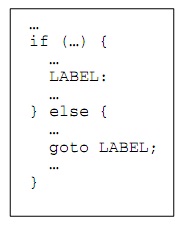Unconditional Jumps: Jumps which are not strictly upwards in the block hierarchy can require extensive control-flow manipulation, including creation of redundant code, and should be avoided if possible. Such jumps add considerable modeling overhead for some model checkers. For example, gotos are not directly supported in JPF, but SPIN does handle them by default:
